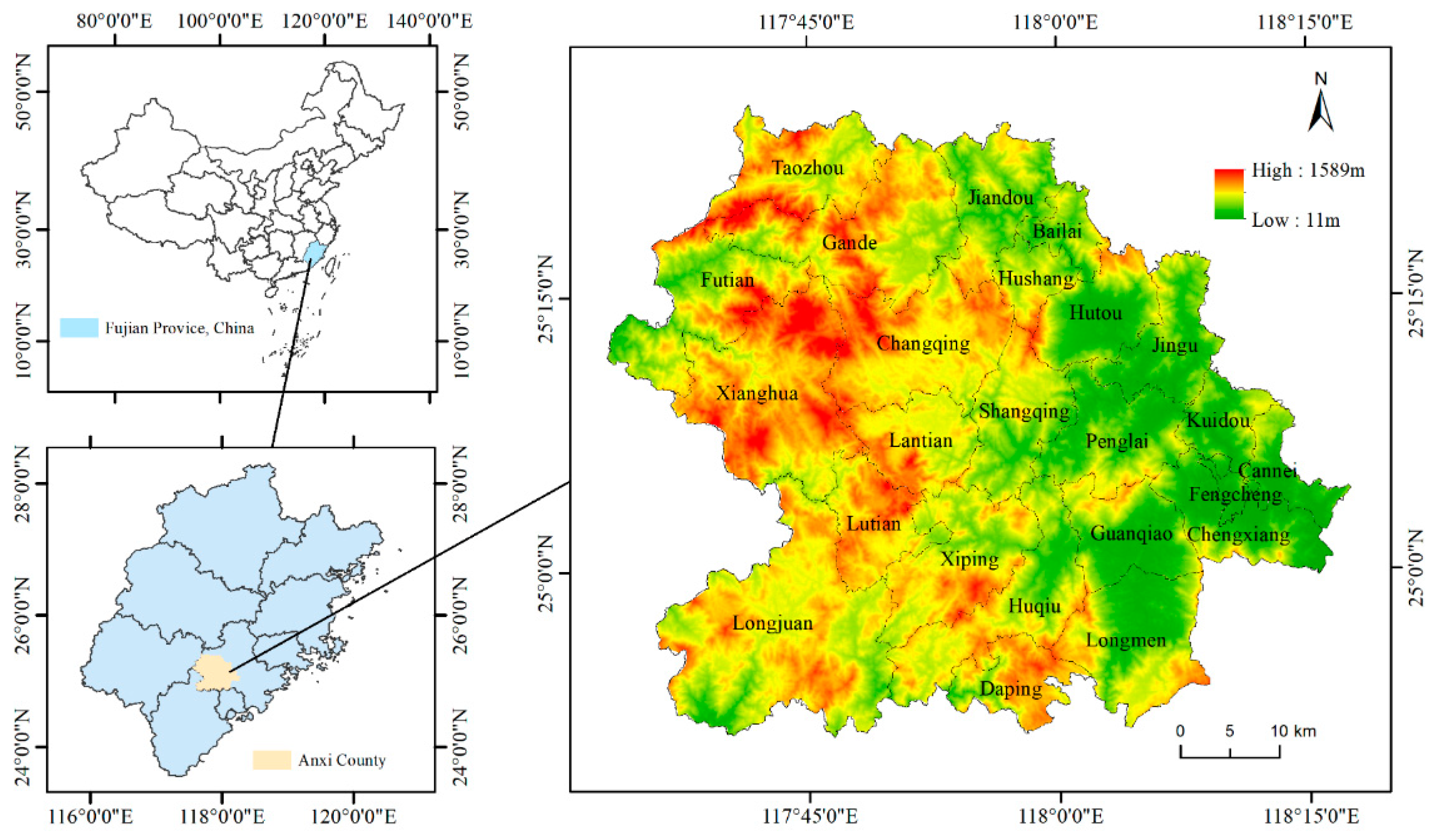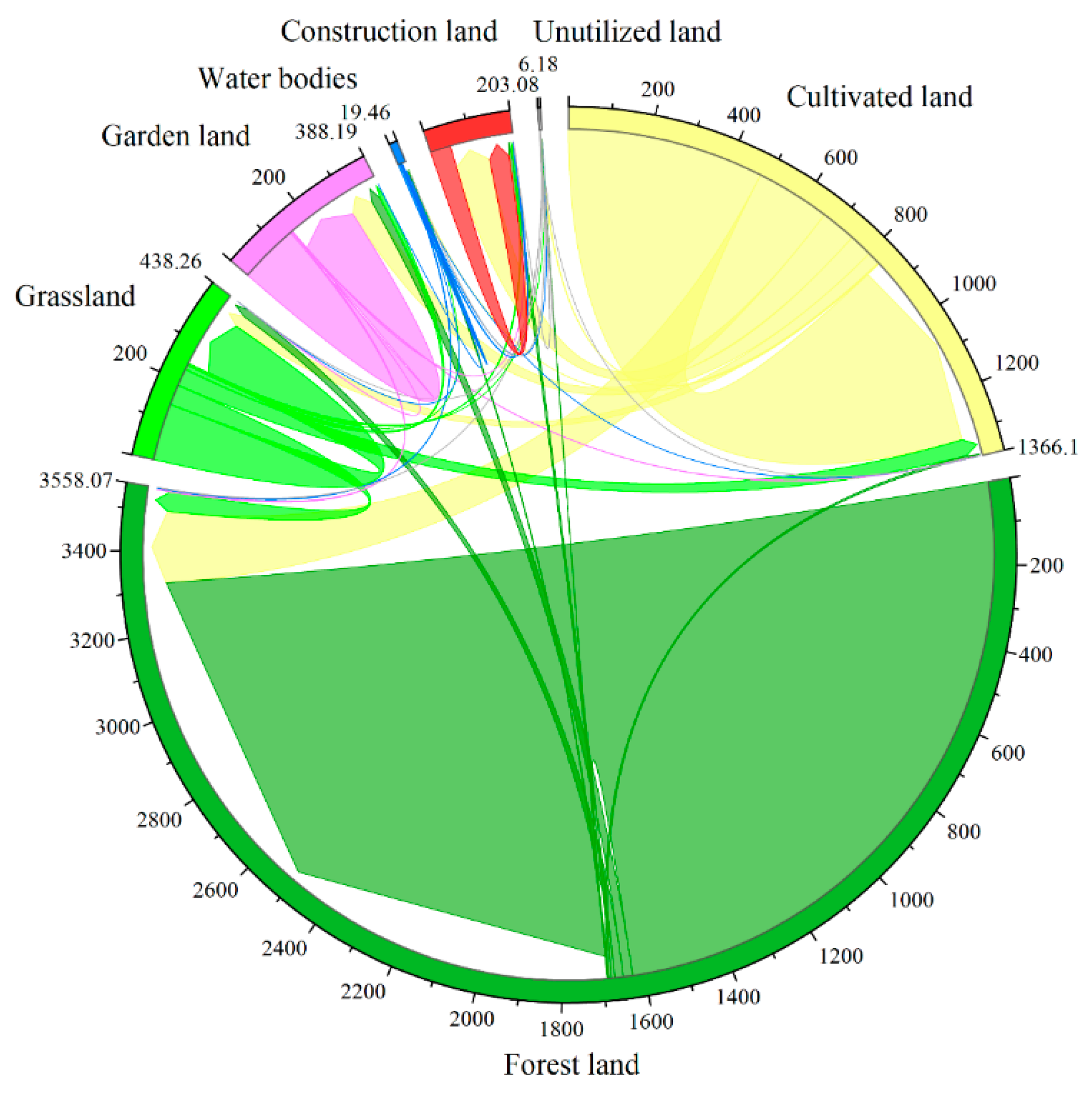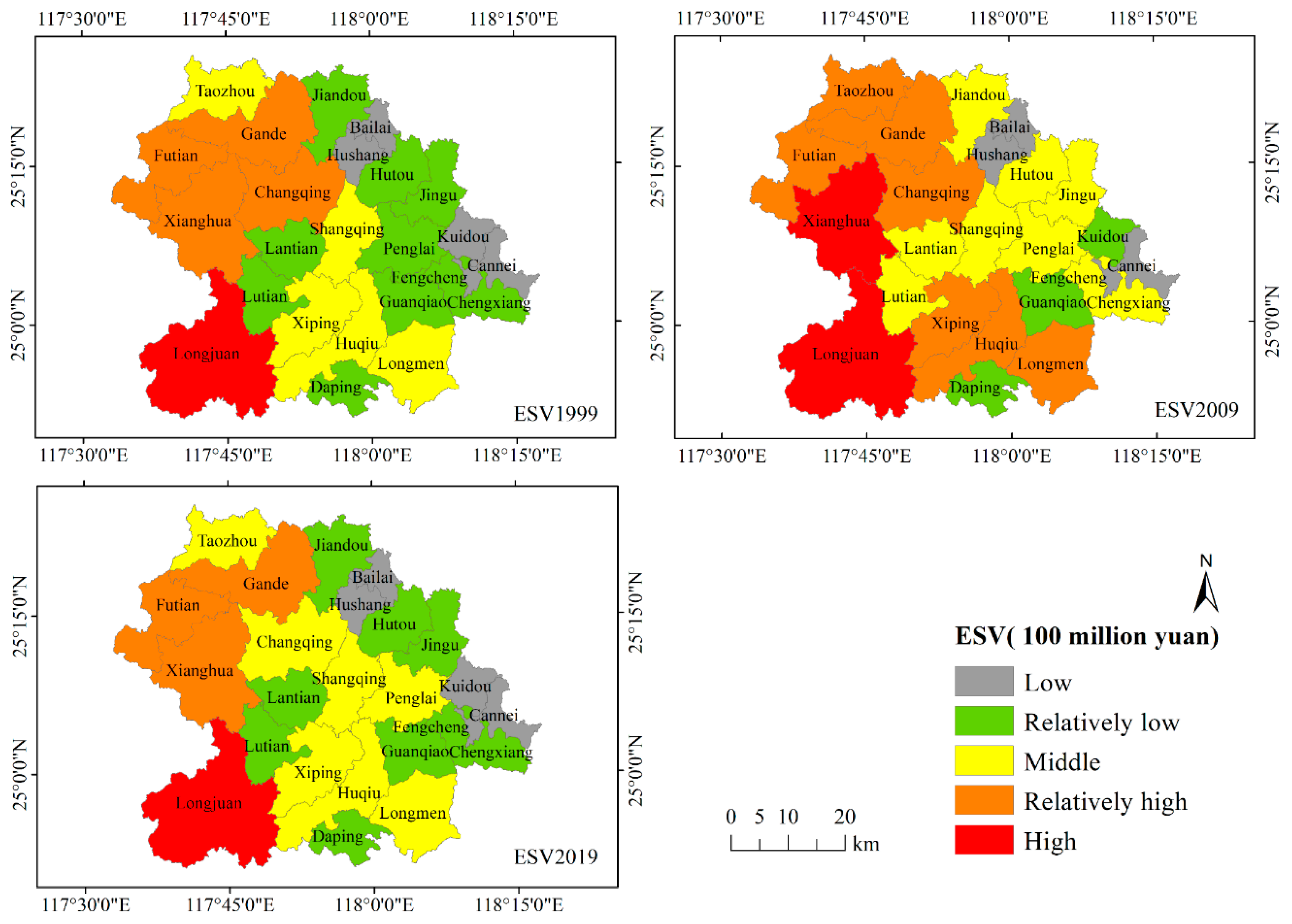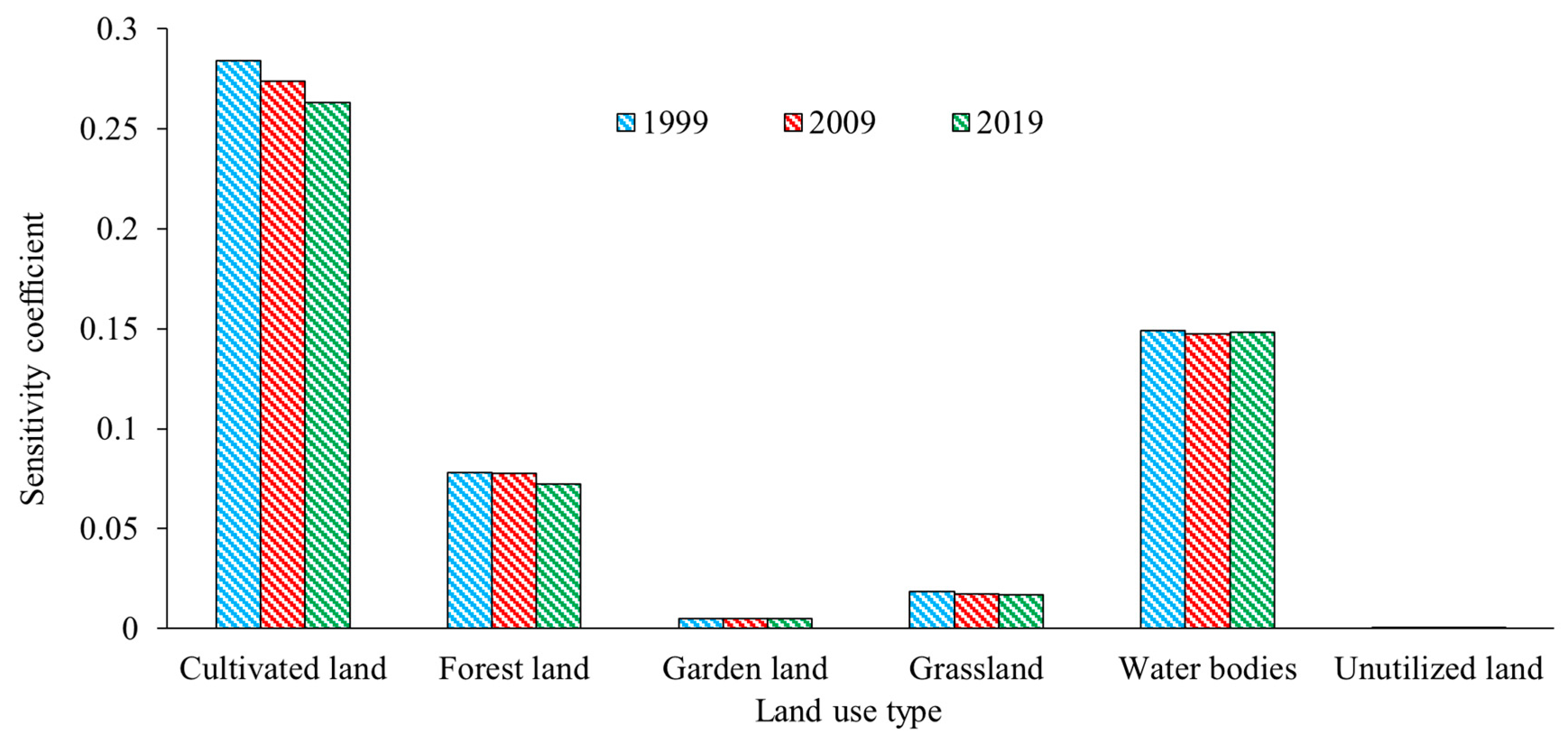Evaluating the Spatial Evolution of the Eco-Economy Harmony in Anxi County, China, Based on Ecosystem Services Value
Abstract
1. Introduction
2. Literature Review
3. Study Area and Methods
3.1. Study Area
3.2. Data Collection and Processing
3.3. Research Methodology
3.3.1. Accuracy Evaluation
3.3.2. Single Land-Use Dynamic Degree (K)
3.3.3. Regional Ecosystem Services Valuation Modelling (ESV)
3.3.4. Sensitivity Analysis (CS)
3.3.5. Eco-Economic Harmony Modelling (EEH)
4. Results
4.1. Characteristics of Land-Use Change
4.2. Changes in Ecosystem Services Value
4.3. Sensitivity Analysis
4.4. Analysis of EEH
5. Discussion
5.1. Land-Use Change
5.2. Evolution Characteristics of Ecosystem Services Value (ESV)
5.3. Eco-Economic Harmony State and Changes
5.4. Policy Implications
6. Conclusions
Author Contributions
Funding
Institutional Review Board Statement
Informed Consent Statement
Data Availability Statement
Conflicts of Interest
References
- Fang, C.L.; Zhou, C.H.; Gu, C.L.; Chen, L.D.; Li, S.C. A Proposal for the Theoretical Analysis of the Interactive Coupled Effects between Urbanization and the Eco-Environment in Mega-Urban Agglomerations. J. Geogr. Sci. 2017, 27, 1431–1449. [Google Scholar] [CrossRef]
- Chen, W.X.; Chi, G.Q. Urbanization and Ecosystem Services: The Multi-Scale Spatial Spillover Effects and Spatial Variations. Land Use Policy 2022, 114, 105964. [Google Scholar] [CrossRef]
- Wu, Y.Z.; Huang, Z.C.; Han, D.; Qiu, X.L.; Pan, Y.X. Evolution of Urban Ecosystem Service Value and a Scenario Analysis Based on Land Utilization Changes: A Case Study of Hangzhou, China. Sustainability 2023, 15, 8274. [Google Scholar] [CrossRef]
- He, J.; Yu, Y.; Sun, L.X.; Zhang, H.Y.; Malik, I.; Wistuba, M.; Yu, R. Spatiotemporal Change in the Land Use and Ecosystem Service Value in the Aral Sea Basin (1993–2018). Environ. Sci. Pollut. Res. 2022, 29, 74416–74427. [Google Scholar] [CrossRef] [PubMed]
- Chen, H.Z.; Chen, Y.; Chen, X.S.; Zhang, X.Z.; Wu, H.W.; Li, Z.H. Impacts of Historical Land Use Changes on Ecosystem Services in Guangdong Province, China. Land 2022, 11, 809. [Google Scholar] [CrossRef]
- Fu, B.L.; Li, Y.; Zhang, B.; Yin, B.S.; Zhu, H.L.; Xing, Z.F. Dynamic Evaluation of Ecosystem Service Value of the Riparian Zone Based on Remote Sensing from 1986 to 2012. Solid Earth Discuss. 2015, 7, 2151–2184. [Google Scholar]
- Costanza, R.; D’arge, R.; De Groot, R.; Farber, S.; Grasso, M.; Hannon, B.; Limburg, K.; Naeem, S.; O’neill, R.V.; Paruelo, J.; et al. The Value of the World’s Ecosystem Services and Natural Capital. Ecol. Econ. 1997, 387, 253–260. [Google Scholar] [CrossRef]
- Mamat, Z.; Yimit, H.; Eziz, M.; Ablimit, A. Analysis of the Ecology-Economy Coordination Degree in Yanqi Basin, Xinjiang, China. Asian J. Chem. 2013, 25, 9034–9040. [Google Scholar] [CrossRef]
- Jiao, L.; Yang, R.; Zhang, Y.L.; Yin, J.; Huang, J.Y. The Evolution and Determinants of Ecosystem Services in Guizhou—A Typical Karst Mountainous Area in Southwest China. Land 2022, 11, 1164. [Google Scholar] [CrossRef]
- Feng, Z.; Jin, X.R.; Chen, T.Q.; Wu, J.S. Understanding Trade-Offs and Synergies of Ecosystem Services to Support the Decision-Making in the Beijing–Tianjin–Hebei Region. Land Use Policy 2021, 106, 105446. [Google Scholar] [CrossRef]
- Farley, J.; Costanza, R. Payments for Ecosystem Services: From Local to Global. Ecol. Econ. 2010, 69, 2060–2068. [Google Scholar] [CrossRef]
- Ouyang, Z.; Song, C.; Song, C.; Zheng, H.; Zheng, H.; Polasky, S.; Polasky, S.; Xiao, Y.; Xiao, Y.; Bateman, I.J.; et al. Using Gross Ecosystem Product (GEP) to Value Nature in Decision Making. Proc. Natl. Acad. Sci. USA 2020, 117, 14593–14601. [Google Scholar] [CrossRef]
- Fu, B.J.; Su, C.H.; Wei, Y.P.; Willett, I.R.; Lü, Y.H.; Liu, G.H. Double Counting in Ecosystem Services Valuation: Causes and Countermeasures. Ecol. Res. 2011, 26, 1–14. [Google Scholar] [CrossRef]
- Jiang, W.; Wu, T.; Fu, B.J. The Value of Ecosystem Services in China: A Systematic Review for Twenty Years. Ecosyst. Serv. 2021, 52, 101365. [Google Scholar] [CrossRef]
- Xie, G.D.; Li, W.H.; Xiao, Y.; Zhang, B.; Lu, C.X.; An, K.; Wang, J.X.; Xu, K.; Wang, J.Z. Forest Ecosystem Services and Their Values in Beijing. Chin. Geogr. Sci. 2010, 20, 51–58. [Google Scholar] [CrossRef]
- Yu, G.; Lu, C.X.; Xie, G.D.; Luo, Z.J.; Yang, L. Grassland Ecosystem Services and Their Economic Evaluation in Qinghai-Tibetan Plateau Based on RS and GIS. Int. Geosci. Remote Sens. Symp. 2005, 4, 2961–2964. [Google Scholar]
- Xie, G.D.; Zhang, C.X.; Zhang, L.M.; Chen, W.H.; Li, S.M. Improvement of the Evaluation Method for Ecosystem Service Value Based on Per Unit Area. J. Nat. Resour. 2015, 30, 1243–1254. [Google Scholar]
- Xie, G.D.; Zhang, C.X.; Zhen, L.; Zhang, L.M. Dynamic Changes in the Value of China’s Ecosystem Services. Ecosyst. Serv. 2017, 26, 146–154. [Google Scholar] [CrossRef]
- Xiong, X.X.; Zhou, T.T.; Cai, T.; Huang, W.; Li, J.; Cui, X.F.; Li, F. Land Use Transition and Effects on Ecosystem Services in Water-Rich Cities under Rapid Urbanization: A Case Study of Wuhan City, China. Land 2022, 11, 1153. [Google Scholar] [CrossRef]
- Rodríguez, J.P.; Beard, T.D., Jr.; Bennett, E.M.; Cumming, G.S.; Cork, S.J.; Agard, J.; Dobson, A.P.; Peterson, G.D. Trade-Offs across Space, Time, and Ecosystem Services. Ecol. Soc. 2006, 11, 28. [Google Scholar] [CrossRef]
- Chan, K.M.A.; Shaw, M.R.; Cameron, D.R.; Underwood, E.C.; Daily, G.C. Conservation Planning for Ecosystem Services. PLoS Biol. 2006, 4, e379. [Google Scholar] [CrossRef]
- Zhang, Z.; Xia, F.; Yang, D.; Huo, J.; Wang, G.; Chen, H. Spatiotemporal Characteristics in Ecosystem Service Value and Its Interaction with Human Activities in Xinjiang, China. Ecol. Indic. 2020, 110, 105826. [Google Scholar] [CrossRef]
- Li, F.; Zhang, S.W.; Yang, J.C.; Chang, L.P.; Yang, H.J.; Bu, K. Effects of Land Use Change on Ecosystem Services Value in West Jilin since the Reform and Opening of China. Ecosyst. Serv. 2018, 31, 12–20. [Google Scholar]
- Liu, L. A Sustainability Index with Attention to Environmental Justice for Eco-City Classification and Assessment. Ecol. Indic. 2018, 85, 904–914. [Google Scholar] [CrossRef]
- Mathewos, M.; Aga, A.O. Evaluation of the Linkages between Ecosystem Services and Land Use/Land Cover Changes in Matenchose Watershed, Rift Valley Basin, Ethiopia. Quaternary 2023, 6, 13. [Google Scholar] [CrossRef]
- Ye, Y.Q.; Zhang, J.E.; Wang, T.; Bai, H.; Wang, X.; Zhao, W. Changes in Land-Use and Ecosystem Service Value in Guangdong Province, Southern China, from 1990 to 2018. Land 2021, 10, 426. [Google Scholar] [CrossRef]
- Chen, W.X.; Zhao, H.B.; Li, J.F.; Zhu, L.J.; Wang, Z.Y.; Zeng, J. Land Use Transitions and the Associated Impacts on Ecosystem Services in the Middle Reaches of the Yangtze River Economic Belt in China Based on the Geo-Informatic Tupu Method. Sci. Total Environ. 2020, 701, 134690. [Google Scholar] [CrossRef]
- Ma, S.; Qiao, Y.P.; Wang, L.J.; Zhang, J.C. Terrain Gradient Variations in Ecosystem Services of Different Vegetation Types in Mountainous Regions: Vegetation Resource Conservation and Sustainable Development. For. Ecol. Manag. 2021, 482, 118856. [Google Scholar] [CrossRef]
- Chen, T.; Peng, L.; Wang, Q.; Liu, S. Measuring the Coordinated Development of Ecological and Economic Systems in Hengduan Mountain Area. Sustainability 2017, 9, 1270. [Google Scholar] [CrossRef]
- Suh, S. Theory of Materials and Energy Flow Analysis in Ecology and Economics. Ecol. Model. 2005, 189, 251–269. [Google Scholar] [CrossRef]
- Common, M.; Perrings, C. Towards an Ecological Economics of Sustainability. Econ. Sustain. 2017, 6, 199–226. [Google Scholar]
- Costanza, R.; de Groot, R.; Sutton, P.; van der Ploeg, S.; Anderson, S.J.; Kubiszewski, I.; Farber, S.; Turner, R.K. Changes in the Global Value of Ecosystem Services. Glob. Environ. Chang. 2014, 26, 152–158. [Google Scholar] [CrossRef]
- Zhang, Y.; Zhao, D.F.; Lin, J.S.; Jiang, L.; Huang, B.F.; Jiang, F.S.; Wang, M.K.; Ge, H.L.; Huang, Y.H. Impacts of Collapsing Gullies on the Dynamics of Soil Organic Carbon in the Red Soil Hilly Region of Southeast China. Catena 2020, 190, 104547. [Google Scholar] [CrossRef]
- Lu, Y.Y.; Xu, X.L.; Zhao, J.H.; Han, F. Spatiotemporal Evolution of Mountainous Ecosystem Services in an Arid Region and Its Influencing Factors: A Case Study of the Tianshan Mountains in Xinjiang. Land 2022, 11, 2164. [Google Scholar] [CrossRef]
- Kou, J.; Wang, J.J.; Ding, J.L.; Ge, X.Y. Spatial Simulation and Prediction of Land Use/Land Cover in the Transnational Ili-Balkhash Basin. Remote Sens. 2023, 15, 3059. [Google Scholar] [CrossRef]
- GB/T 21010-2017; The Classification of Current Land-Use Situation. Standards Press of China: Beijing, China, 2017.
- Liu, W.; Zhan, J.Y.; Zhao, F.; Yan, H.M.; Zhang, F.; Wei, X.Q. Impacts of Urbanization-Induced Land-Use Changes on Ecosystem Services: A Case Study of the Pearl River Delta Metropolitan Region, China. Ecol. Indic. 2019, 98, 228–238. [Google Scholar] [CrossRef]
- Redo, D.J.; Aide, T.M.; Clark, M.L.; Andrade-Núñez, M.J. Impacts of Internal and External Policies on Land Change in Uruguay, 2001–2009. Environ. Conserv. 2012, 39, 122–131. [Google Scholar] [CrossRef]
- Su, K.; Wei, D.Z.; Lin, W.X. Evaluation of Ecosystem Services Value and Its Implications for Policy Making in China—A Case Study of Fujian Province. Ecol. Indic. 2020, 108, 105752. [Google Scholar] [CrossRef]
- Mosammam, H.M.; Nia, J.T.; Khani, H.; Teymouri, A.; Kazemi, M. Monitoring Land Use Change and Measuring Urban Sprawl Based on Its Spatial Forms: The Case of Qom City. Egypt. J. Remote Sens. Space Sci. 2017, 20, 103–116. [Google Scholar]
- Wang, M.; Sun, X.F. Potential Impact of Land Use Change on Ecosystem Services in China. Environ. Monit. Assess. 2016, 188, 248. [Google Scholar] [CrossRef]
- Fu, J.; Zhang, Q.; Wang, P.; Zhang, L.; Tian, Y.Q.; Li, X.R. Spatio-Temporal Changes in Ecosystem Service Value and Its Coordinated Development with Economy: A Case Study in Hainan Province, China. Remote Sens. 2022, 14, 970. [Google Scholar] [CrossRef]
- Zhu, S.C.; Huang, J.L.; Zhao, Y.L. Coupling Coordination Analysis of Ecosystem Services and Urban Development of Resource-Based Cities: A Case Study of Tangshan City. Ecol. Indic. 2022, 136, 108706. [Google Scholar] [CrossRef]
- Mamat, A.; Halik, Ü.; Rouzi, A. Variations of Ecosystem Service Value in Response to Land-Use Change in the Kashgar Region, Northwest China. Sustainability 2018, 10, 200. [Google Scholar] [CrossRef]
- Cao, S.; Zhai, Q.M. Analysis of Harmonious Development of Eco-Economic System in the Second Green Isolation Area in Beijing. Discret. Dyn. Nat. Soc. 2022, 2022, 7009929. [Google Scholar] [CrossRef]
- Wang, X.M.; Xu, M.; Zhang, Y.; Xu, N.Z.; Zhang, Y.H. Evaluation of Eco-Economy Harmony and Spatial Evolution of the Urban Agglomeration Area in the Great Pearl River Delta. IOP Conf. Ser. Earth Environ. Sci. 2018, 153, 062035. [Google Scholar] [CrossRef]
- Das, S.; Sarkar, R. Predicting the Land Use and Land Cover Change Using Markov Model: A Catchment Level Analysis of the Bhagirathi-Hugli River. Spat. Inf. Res. 2019, 27, 439–452. [Google Scholar] [CrossRef]
- Li, W.; Geng, J.W.; Bao, J.L.; Lin, W.X.; Wu, Z.Y.; Fan, S.S. Spatial and Temporal Evolution Patterns of Habitat Quality under Tea Plantation Expansion and Multi-Scenario Simulation Study: Anxi County as an Example. Land 2023, 12, 1308. [Google Scholar] [CrossRef]
- Xin, R.; Skov-Petersen, H.; Zeng, J.; Zhou, J.; Li, K.; Hu, J.; Liu, X.; Kong, J.; Wang, Q. Identifying Key Areas of Imbalanced Supply and Demand of Ecosystem Services at the Urban Agglomeration Scale: A Case Study of the Fujian Delta in China. Sci. Total Environ. 2021, 791, 148173. [Google Scholar] [CrossRef]
- Li, S.; Cao, Y.; Liu, J.; Wang, S.; Zhou, W. Assessing Spatiotemporal Dynamics of Land Use and Cover Change and Carbon Storage in China’s Ecological Conservation Pilot Zone: A Case Study in Fujian Province. Remote Sens. 2022, 14, 4111. [Google Scholar] [CrossRef]
- Lei, J.C.; Wang, S.; Wang, J.M.; Wu, S.Q.; You, X.B.; Wu, J.; Cui, P.; Ding, H. Effects of Land Use Change on Ecosystem Services Value of Xunwu County. Acta Ecol. Sin. 2019, 39, 3089–3099. [Google Scholar]
- Wu, Z.Y.; Li, J.J.; Zheng, J.; Liu, J.F.; Liu, S.Y.; Lin, W.X.; Wu, C.Z. Soil Microbial Community Structure and Catabolic Activity Are Significantly Degenerated in Successive Rotations of Chinese Fir Plantations. Sci. Rep. 2017, 7, 6691. [Google Scholar] [CrossRef]
- Quan, B.; Bai, Y.J.; Römkens, M.J.M.; Chang, K.T.; Song, H.; Guo, T.; Lei, S. Urban Land Expansion in Quanzhou City, China, 1995–2010. Habitat Int. 2015, 48, 131–139. [Google Scholar] [CrossRef]
- Song, W.; Deng, X.Z. Effects of Urbanization-Induced Cultivated Land Loss on Ecosystem Services in the North China Plain. Energies 2015, 8, 5678–5693. [Google Scholar] [CrossRef]
- Polasky, S.; Nelson, E.; Camm, J.; Csuti, B.; Fackler, P.; Lonsdorf, E.; Montgomery, C.; White, D.; Arthur, J.; Garber-Yonts, B.; et al. Where to Put Things? Spatial Land Management to Sustain Biodiversity and Economic Returns. Biol. Conserv. 2008, 141, 1505–1524. [Google Scholar] [CrossRef]
- Liu, S.; Yao, X.; Zhao, D.; Lu, L. Evaluation of the Ecological Benefits of Tea Gardens in Meitan County, China, Using the InVEST Model. Environ. Dev. Sustain. 2021, 23, 7140–7155. [Google Scholar] [CrossRef]
- Li, W.; Yi, P.; Zhang, D.; Zhou, Y. Assessment of Coordinated Development between Social Economy and Ecological Environment: Case Study of Resource-Based Cities in Northeastern China. Sustain. Cities Soc. 2020, 59, 102208. [Google Scholar] [CrossRef]
- Xu, X.; Yang, G.; Tan, Y.; Liu, J.; Hu, H. Ecosystem Services Trade-Offs and Determinants in China’s Yangtze River Economic Belt from 2000 to 2015. Sci. Total Environ. 2018, 634, 1601–1614. [Google Scholar] [CrossRef] [PubMed]
- Wang, C.; Zhao, M.; Xu, Y.; Zhao, Y.; Zhang, X. Ecosystem Service Synergies Promote Ecological Tea Gardens: A Case Study in Fuzhou, China. Remote Sens. 2023, 15, 540. [Google Scholar] [CrossRef]
- Fisher, B.; Turner, R.K.; Morling, P. Defining and Classifying Ecosystem Services for Decision Making. Ecol. Econ. 2009, 68, 643–653. [Google Scholar] [CrossRef]







| Year | Sensor | Band Signal | Cloudage | Date |
|---|---|---|---|---|
| 1999 | TM | 119043 | 0.3 | 9.15 |
| 120042 | 0.01 | 4.17 | ||
| 120043 | 0.19 | 4.17 | ||
| 2009 | TM | 119043 | 0.29 | 10.19 |
| 120042 | 0.43 | 10.03 | ||
| 120043 | 0.1 | 10.03 | ||
| 2019 | OLI | 119043 | 0.13 | 9.26 |
| 120042 | 0.26 | 12.02 | ||
| 120043 | 0.23 | 12.02 |
| Area | Year | Town Engel Coefficient | Rural Engel Coefficient | Urban Population Proportion (%) | Per Capita GDP (CNY) | Annual Precipitation (mm) | Annual Average Temperature (°C) |
|---|---|---|---|---|---|---|---|
| Anxi County | 1999 | 0.435 | 0.469 | 0.3577 | 6756.00 | 1841.2 | 21.5 |
| 2009 | 0.389 | 0.424 | 0.4788 | 23,555.07 | 1074.4 | 21.9 | |
| 2019 | 0.3209 | 0.4083 | 0.567 | 60,800.00 | 1466.9 | 21.8 | |
| Nationwide | 1999 | 0.421 | 0.526 | 0.362 | 7229.00 | 629.0 | 9.7 |
| 2009 | 0.365 | 0.41 | 0.499 | 26,180.00 | 591.1 | 9.9 | |
| 2019 | 0.276 | 0.3 | 0.5958 | 70,892.00 | 645.5 | 10.34 |
| EEH | Type | EEH | Type |
|---|---|---|---|
| 0.8 ≤ EEH < 1 | High coordination zone | −0.2 ≤ EEH < 0 | Transitional zone |
| 0.6 ≤ EEH < 0.8 | Relatively high coordination zone | −0.4 ≤ EEH < −0.2 | Relatively low conflict zone |
| 0.4 ≤ EEH < 0.5 | Moderate coordination zone | −0.6 ≤ EEH < −0.4 | Moderate conflict zone |
| 0.2 ≤ EEH < 0.4 | Relatively low coordination zone | −0.8 ≤ EEH < −0.6 | Relatively high conflict zone |
| 0 ≤ EEH < 0.2 | Latent crisis area | EEH < −0.8 | High conflict zone |
| Land Use Type | 1999 | 2009 | 2019 | The Degree of Dynamism of Land Use/% | |||||
|---|---|---|---|---|---|---|---|---|---|
| Area (km2) | Ratios (%) | Area (km2) | Ratios (%) | Area (km2) | Ratios (%) | 1999–2009 | 2009–2019 | 1999–2019 | |
| Cultivated land | 837.20 | 28.00 | 662.63 | 22.16 | 528.92 | 17.69 | −2.09 | −2.02 | −1.84 |
| Forest land | 1691.31 | 56.57 | 1808.37 | 60.49 | 1866.76 | 62.44 | 0.69 | 0.32 | 0.52 |
| Garden land | 151.41 | 5.06 | 178.36 | 5.97 | 236.79 | 7.92 | 1.78 | 3.28 | 2.82 |
| Grassland | 247.49 | 8.28 | 228.27 | 7.64 | 190.78 | 6.38 | −0.78 | −2.29 | −0.82 |
| Water bodies | 10.15 | 0.34 | 8.79 | 0.29 | 9.32 | 0.31 | −1.34 | −0.82 | −0.41 |
| Construction land | 50.01 | 1.67 | 97.52 | 3.26 | 153.07 | 5.12 | 9.50 | 5.70 | 10.31 |
| Unutilized land | 2.13 | 0.07 | 5.75 | 0.19 | 4.05 | 0.14 | 17.05 | −2.96 | 4.52 |
| Top Classification of Ecosystem Services (TCES) | Secondary Classification of Ecosystem Services (SCES) | Cultivated Land | Forest Land | Garden Land | Grassland | Water Bodies | Unutilized Land |
|---|---|---|---|---|---|---|---|
| Provisioning services (PS) | Food production, FP | 3157.33 | 721.47 | 1939.40 | 666.71 | 1142.92 | 14.29 |
| Material production, MP | 700.04 | 1657.24 | 1178.64 | 981.01 | 328.59 | 42.86 | |
| Water supply, WS | −3728.79 | 857.19 | −1435.80 | 542.89 | 14,929.45 | 28.57 | |
| Regulating services (RS) | Gas regulation, GS | 2543.01 | 5450.32 | 3996.66 | 3447.82 | 1357.22 | 185.73 |
| Climate regulation, CR | 1328.65 | 16,308.10 | 8818.38 | 9114.82 | 4043.09 | 142.87 | |
| Purify environment, PE | 385.74 | 4778.85 | 2582.29 | 3009.70 | 8157.62 | 585.75 | |
| Hydrologic adjustment, HD | 4271.68 | 10672.06 | 7471.87 | 6676.58 | 156,252.04 | 342.88 | |
| Supporting services (SS) | Soil conservation, SC | 1485.80 | 6636.10 | 4060.95 | 4200.25 | 1328.65 | 214.30 |
| Maintaining nutrient cycle, MNC | 442.88 | 507.17 | 475.03 | 323.83 | 100.01 | 14.29 | |
| Bio-diversity, BD | 485.74 | 6043.21 | 3264.48 | 3819.27 | 3657.36 | 200.01 | |
| Cultural services (CS) | Aesthetic landscape, AL | 214.30 | 2650.16 | 1432.23 | 1685.81 | 2828.74 | 85.72 |
| Year | Cultivated Land | Forest Land | Garden Land | Grassland | Water Bodies | Unutilized Land | Total | |
|---|---|---|---|---|---|---|---|---|
| ESV | 1999 | 15.41 | 155.24 | 8.34 | 13.91 | 3.21 | 0.01 | 196.12 |
| 2009 | 9.36 | 127.40 | 7.54 | 9.85 | 2.14 | 0.01 | 156.30 | |
| 2019 | 7.27 | 127.88 | 9.74 | 8.00 | 2.20 | 0.01 | 155.10 | |
| Change rate/% | 1999–2009 | −0.39 | −0.18 | −0.10 | −0.29 | −0.34 | 1.08 | −0.20 |
| 2009–2019 | −0.22 | 0.00 | 0.29 | −0.19 | 0.03 | −0.32 | −0.01 | |
| 1999–2019 | −0.53 | −0.18 | 0.17 | −0.42 | −0.31 | 0.42 | −0.21 |
| Secondary Classification of Ecosystem Services | Ecosystem Services Value (CNY 108) | Average | ||
|---|---|---|---|---|
| 1999 | 2009 | 2019 | 1999–2019 | |
| Food production, FP | 7.07 | 4.89 | 4.40 | 5.45 |
| Material production, MP | 6.22 | 4.88 | 4.79 | 5.30 |
| Water supply, WS | −2.61 | −1.15 | −0.57 | −1.45 |
| Gas regulation, GS | 20.91 | 16.34 | 15.99 | 17.75 |
| Climate regulation, CR | 52.72 | 42.64 | 42.61 | 45.99 |
| Purifying environment, PE | 15.70 | 12.67 | 12.65 | 13.67 |
| Hydrologic adjustment, HD | 42.39 | 33.00 | 32.48 | 35.96 |
| Soil conservation, SC | 23.05 | 18.38 | 18.20 | 19.88 |
| Maintaining nutrient cycle, MNC | 2.25 | 1.72 | 1.65 | 1.87 |
| Bio-diversity, BD | 19.74 | 15.94 | 15.91 | 17.20 |
| Aesthetic landscape, AL | 8.68 | 7.01 | 7.00 | 7.56 |
| Total | 196.12 | 156.30 | 155.10 | 169.17 |
| 1999–2009 | 2009–2019 | 1999–2019 | |||
|---|---|---|---|---|---|
| EEH | Type | EEH | Type | EEH | Type |
| −0.210 | Relatively low conflict zone | −0.003 | Transitional zone | −0.072 | Transitional zone |
Disclaimer/Publisher’s Note: The statements, opinions and data contained in all publications are solely those of the individual author(s) and contributor(s) and not of MDPI and/or the editor(s). MDPI and/or the editor(s) disclaim responsibility for any injury to people or property resulting from any ideas, methods, instructions or products referred to in the content. |
© 2024 by the authors. Licensee MDPI, Basel, Switzerland. This article is an open access article distributed under the terms and conditions of the Creative Commons Attribution (CC BY) license (https://creativecommons.org/licenses/by/4.0/).
Share and Cite
Hong, X.; Peng, Q.; Zheng, R.; Lin, W.; Fan, S.; Su, K. Evaluating the Spatial Evolution of the Eco-Economy Harmony in Anxi County, China, Based on Ecosystem Services Value. Sustainability 2024, 16, 1491. https://doi.org/10.3390/su16041491
Hong X, Peng Q, Zheng R, Lin W, Fan S, Su K. Evaluating the Spatial Evolution of the Eco-Economy Harmony in Anxi County, China, Based on Ecosystem Services Value. Sustainability. 2024; 16(4):1491. https://doi.org/10.3390/su16041491
Chicago/Turabian StyleHong, Xiaoyan, Qingxia Peng, Rongrong Zheng, Wenxiong Lin, Shuisheng Fan, and Kai Su. 2024. "Evaluating the Spatial Evolution of the Eco-Economy Harmony in Anxi County, China, Based on Ecosystem Services Value" Sustainability 16, no. 4: 1491. https://doi.org/10.3390/su16041491
APA StyleHong, X., Peng, Q., Zheng, R., Lin, W., Fan, S., & Su, K. (2024). Evaluating the Spatial Evolution of the Eco-Economy Harmony in Anxi County, China, Based on Ecosystem Services Value. Sustainability, 16(4), 1491. https://doi.org/10.3390/su16041491






